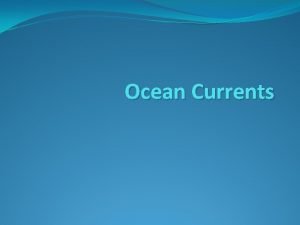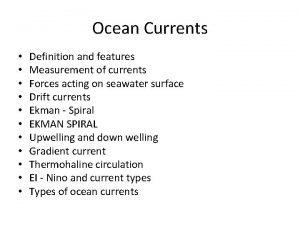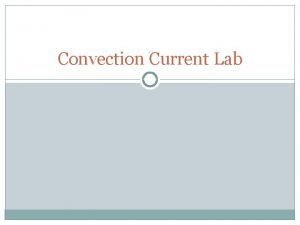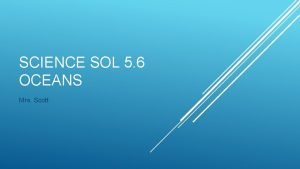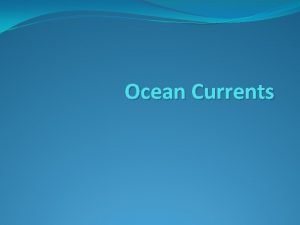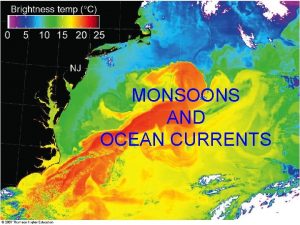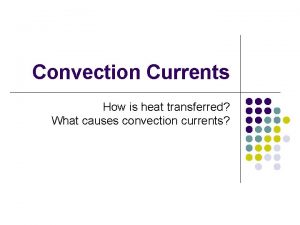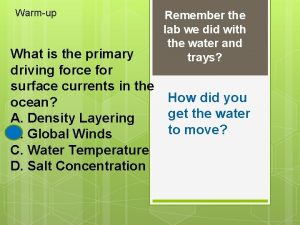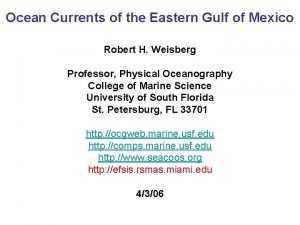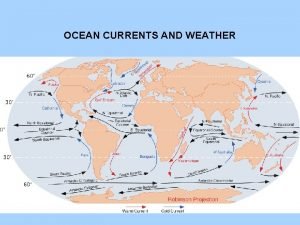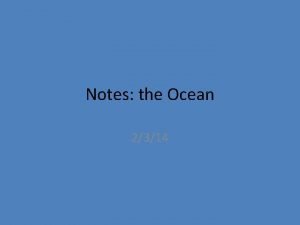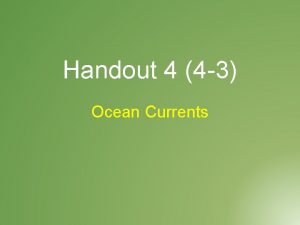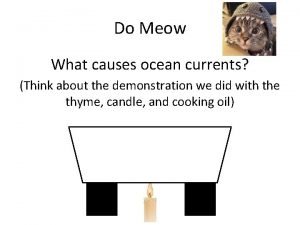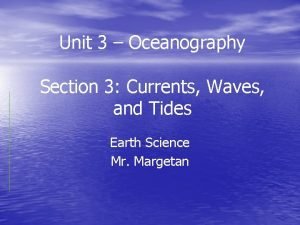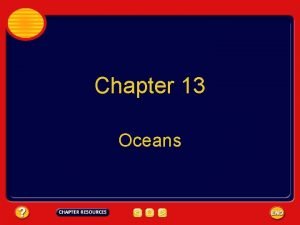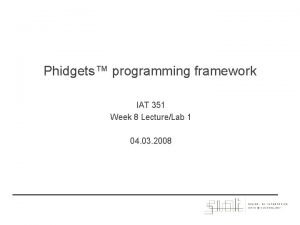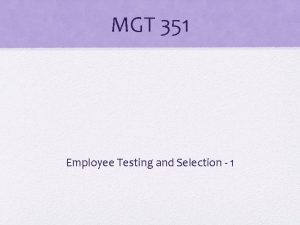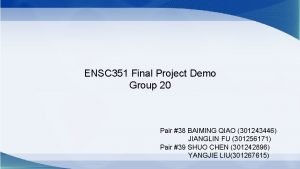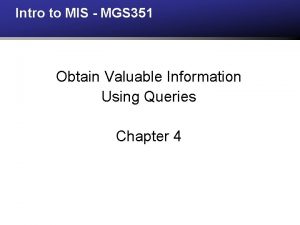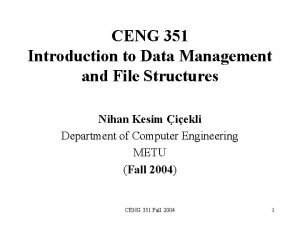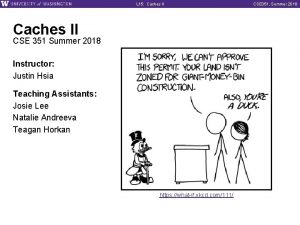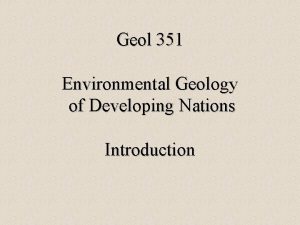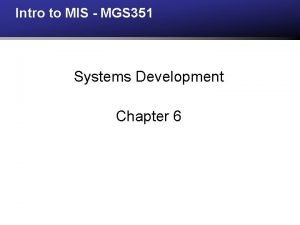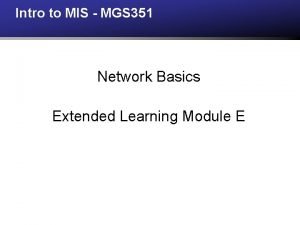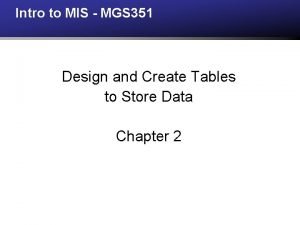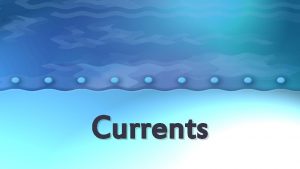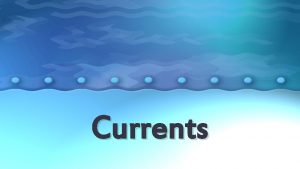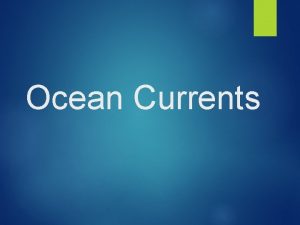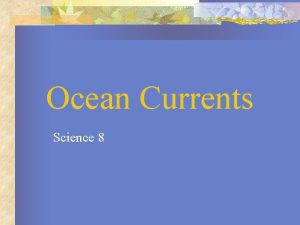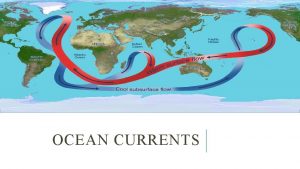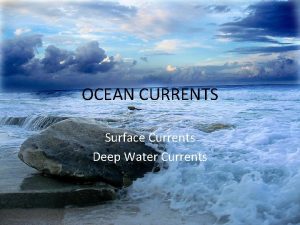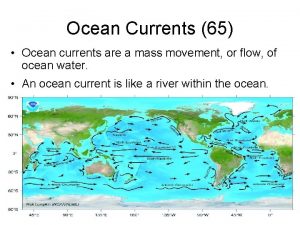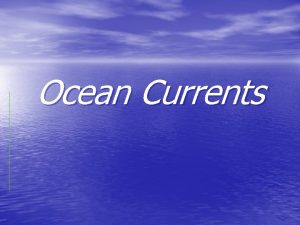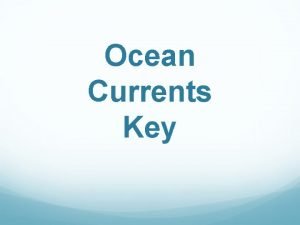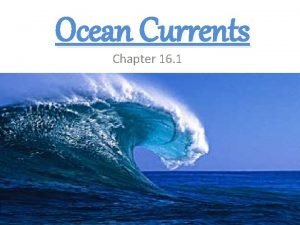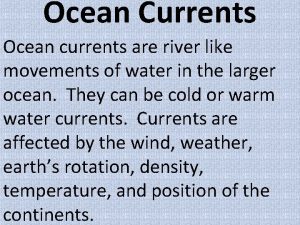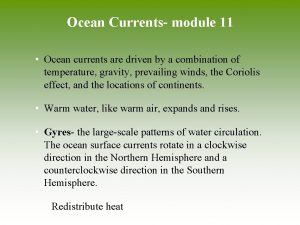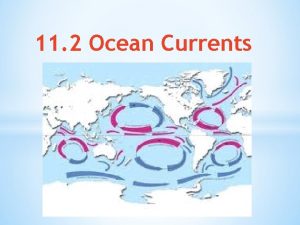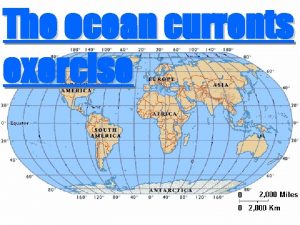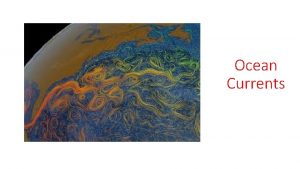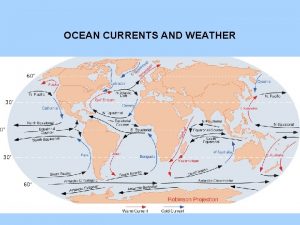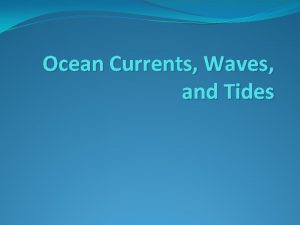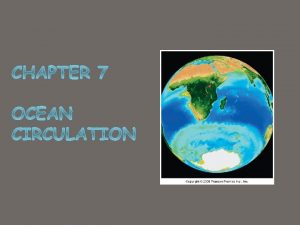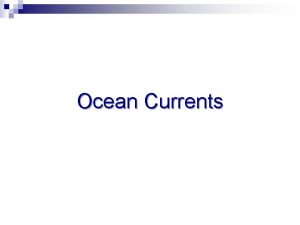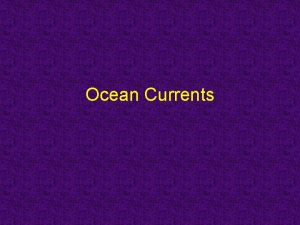Ocean Currents Pages 343 351 Ocean Currents You



































- Slides: 35

Ocean Currents Pages 343 - 351

Ocean Currents • You throw the bottle into the ocean to communicate with the outside world. Can you predict where the bottle will end up? • If you understand ocean currents, you can. • The oceans contain many stream-like movements of water called ocean currents. • There are two main kinds of ocean currents: surface currents and deep currents. • How do Ocean Currents work? https: //www. youtube. com/watch? v=p 4 p. Wafuvdr. Y

Ocean Currents: Surface Currents and Deep Currents


Surface Currents • Surface currents are horizontal streams of water that can flow for thousands of kilometers and can reach depths of hundreds of meters. • Surface currents play a major role in determining climate around the globe.

Currents on the surface are determined by: • the major overall global wind patterns, • the rotation of the Earth (Coriolis effect), • continental deflections (shape of ocean basins).

GLOBAL WINDS • Have you ever blown across a bowl of hot soup? • You may have noticed that your breath pushes the soup across the surface of the bowl. In much the same way, winds that blow across the surface of Earth’s oceans push water across Earth’s surface. • This process causes surface currents in the ocean.


But what makes the wind start to blow? • When sunshine heats up air, the air expands, which means the density of the air decreases and it becomes lighter. Like a balloon, the light warm air floats upward, leaving a slight vacuum below, which pulls in cooler, denser air from the sides. The cooler air coming into the space left by the warm air is wind. • Because the Earth's equator is warmed by the most direct rays of the Sun, air at the equator is hotter than air further north or south. • This hotter air rises up at the equator and as colder air moves in to take its place, winds begin to blow and push the ocean into waves and currents.

Coriolis Effect • The Coriolis Effect causes winds and currents to form circular patterns. • The direction that they spin depend on the hemisphere they are in. • If Earth did not rotate, surface currents would flow in straight lines.

THE CORIOLIS EFFECT • The Coriolis Effect Causes wind and water to move along curved paths. • As Earth rotates, places near the equator travel faster than places closer to the poles. • This difference in speed causes the Coriolis effect. • Wind or water moving from the poles to the equator is deflected to the west. • Wind or water moving from • If Earth did not rotate, surface currents would flow in straight lines. • However, because Earth does rotate, the currents travel along curved paths.

Coriolis Effect Explained • The Earth is a sphere that spins on its axis in a counterclockwise direction when seen from the North Pole. • The further towards one of the poles you move from the equator, the shorter the distance around the Earth. • This means that objects on the equator move faster than objects further from the equator. • While wind or an ocean current moves, the Earth is spinning underneath it. As a result, an object moving north or south along the Earth will appear to move in a curve, instead of in a straight line. • Wind or water that travels toward the poles from the equator is deflected to the east, while wind or water that travels toward the equator from the poles gets bent to the west. • The Coriolis Effect bends the direction of surface currents.

CONTINENTAL DEFLECTIONS • If Earth’s surface were covered only with water, surface currents would travel across the oceans in a uniform pattern. • However, continents cover about one-third of Earth’s surface. • When surface currents meet continents, the currents deflect, or change direction.

Continental Deflection/ shape of ocean basins • When a surface current collides with land, it changes the direction of the currents. • Imagine pushing the water in a bathtub towards the end of the tub. • When the water reaches the edge, it has to change direction.


Ocean Currents are called Ocean Gyres • An ocean gyre is a large system of circular ocean currents formed by global wind patterns and forces created by Earth's rotation. • The movement of the world's major ocean gyres helps drive the “ocean conveyor belt. ” • The ocean conveyor belt circulates ocean water around the entire planet. • There are three major types of ocean gyres: tropical, subtropical, and subpolar. • Animation: https: //www. youtube. com/watch? v=Hu_Ga 0 JYFNg • More info Source: https: //www. nationalgeographic. org/encyclopedia/ocean-gyre/

The Gulf Stream is a strong surface current that brings warm water from the Gulf of Mexico into the Atlantic Ocean, extending all the way up the eastern coast of the United States and Canada. Gulf Stream Explained: https: //www. youtube. com/watch? v=Uu. Gr. Bh. K 2 c 7 U

Garbage Patch • Ocean gyres circle large areas of stationary, calm water. • Debris drifts into these areas and, due to the region’s lack of movement, can accumulate for years. • These regions are called garbage patches. • The Indian Ocean, North Atlantic Ocean, and North Pacific Ocean all have significant garbage patches. • The garbage patch in the North Pacific Ocean is sometimes called the Pacific trash vortex or the Great Pacific Garbage Patch.

Great Pacific Garbage Patch 2015 • Mass of waste spans 1. 6 million square km, about three times the size of France.

HOW SURFACE CURRENTS DISTRIBUTE HEAT 1. Water near the equator absorbs heat energy from the sun. 2. Then, warm-water currents carry the heat from the equator to other parts of the ocean. 3. The heat from the warm-water currents moves into colder water or into the atmosphere.

Deep Currents • There are several main deep currents in the ocean. • Antarctic Bottom Water - deepest and densest, forms near Antarctica. • North Atlantic Deep Water - less dense, forms in the North Atlantic Ocean. • Therefore, North Atlantic Deep Water stays on top of Antarctic Bottom Water when the two meet.

Deep Currents move by convection currents, which are influenced by density • More dense water masses will sink towards the ocean floor. • Just like convection in air, when denser water sinks, its space is filled by less dense water moving in. • This creates convection currents that move enormous amounts of water in the depths of the ocean.

Deep Currents are controlled by Density • Deep Currents are called Thermohaline Currents • Differences in density are due to temperature (thermo) and salinity (haline). • The blue arrows are deep currents and the red ones are surface currents.

Factors affecting Density

Factors affecting Density

Factors affecting Density

Upwelling • A process in which deep, cold water rises toward the surface. • Upwelling is important because it brings oxygen rich water and nutrients to warmer water.

What causes Upwelling? 1. Upwelling happens where wind blows along a coastline. 2. The wind causes the water at the ocean surface to move away from the coast. 3. Allowing deeper water to rise up and takes its place.

Deep currents and surface currents are closely linked: The warm water in surface currents sinks as it cools and becomes the cold water in deep currents.

Global Ocean Conveyor Belt • The global ocean conveyor belt is a constantly moving system of deep-ocean circulation driven by temperature and salinity. It starts in the Norwegian Sea, where warm water from the Gulf Stream heats the atmosphere in the cold northern latitudes and then works its way south, traveling through all of the world's oceans before circling back.

Thermohaline Currents • Bill Nye • https: //www. youtube. com/watch? v=w_8 mw-1 HYFg

Practice • HW: Ocean Current WS or text • Activity: World Ocean Currents Mapping Activity p 352 -353

Surface and Deep Currents are linked • Why is the water temperature cooler in some places? • Water cools as it moves from the equator to the poles via surface currents. • Cooler water is more dense so it begins to sink. As a result, the surface currents and the deep currents are linked. • Wind causes surface currents to transport water around the oceans, while density differences cause deep currents to return that water back around the globe.

What about tides? • Tides are the daily changes in the level of the ocean water at any given place. The main factors that causes tides are the gravitational pull of the Moon and the Sun. • How does the Moon affect the oceans? Since the Moon is a relatively large object in space that is very close to the Earth, its gravity actually pulls Earth's water towards it. Wherever the moon is, as it orbits the Earth, there is a high tide 'bulge' that stays lined up with the Moon. The side of the Earth that is furthest from the Moon also has a high tide 'bulge'. This is because the Earth is closer to the moon than the water on its far side. The Moon's gravity pulls more on the planet than the water on the opposite side. These two water bulges on opposite sides of the Earth aligned with the Moon are the high tides. Since ocean water is pulled higher in the areas of the two high tides, there is less water in between the two high tides. These areas are the low tides • High tide is created by the gravitational pull of the moon which pulls water toward it. Water on the opposite side of the Earth is pulled least by the moon so the water bulges away from the moon. High tide occurs where the water is bulging. Low tide occurs where it is not.

Summary • • • Ocean waves are energy traveling through the water. The highest portion of a wave is the crest and the lowest is the trough. The horizontal distance between two wave crests is the wave's length. Most waves in the ocean are wind generated waves. Tsunami are exceptionally long wavelength waves often caused by earthquakes. Tides are produced by the gravitational pull of the Moon and Sun on Earth's oceans. Spring tides happen at full and new moons, when the Earth, Moon, and Sun are all aligned. Neap tides are tides of lower than normal tidal range that occur at first and last quarter moons, when the Moon is at right angles to the Sun. Ocean surface currents are produced by major overall patterns of atmospheric circulation, the Coriolis Effect and the shape of each ocean basin. Ocean surface circulation brings warm equatorial waters towards the poles and cooler polar water towards the equator. Deep ocean circulation is density driven circulation produced by differences in salinity and temperature of water masses. Upwelling areas are biologically important areas that form as ocean surface waters are blown away from a shore, causing cold, nutrient rich waters to rise to the surface.
 Printed pages vs web pages
Printed pages vs web pages What is a deep current
What is a deep current Citlalli dominguez
Citlalli dominguez Coriolis effect vocabulary
Coriolis effect vocabulary What are ocean currents
What are ocean currents Convection currents ocean
Convection currents ocean Why are tropical climates so hot brainpop
Why are tropical climates so hot brainpop Midnight zone
Midnight zone Ocean currents vocabulary
Ocean currents vocabulary Ocean currents
Ocean currents Ocean currents project
Ocean currents project What causes convection?
What causes convection? What is the primary driving force of surface ocean currents
What is the primary driving force of surface ocean currents Rubber ducks ocean currents activity
Rubber ducks ocean currents activity Ocean currents gulf of mexico
Ocean currents gulf of mexico Gyre
Gyre What are ocean currents
What are ocean currents Ocean currents map
Ocean currents map What are ocean currents
What are ocean currents What factors affect the weather
What factors affect the weather Ocean currents
Ocean currents Ocean currents
Ocean currents Iat 351
Iat 351 Mgt 351 nsu course outline
Mgt 351 nsu course outline Cse 351 lab5
Cse 351 lab5 Balcarce 351 lomas de zamora
Balcarce 351 lomas de zamora Ensc 351
Ensc 351 43.351.097/0001-90
43.351.097/0001-90 Mgs351
Mgs351 Ceng 351
Ceng 351 351 cache simulator
351 cache simulator Mgs 351 ub
Mgs 351 ub Geol 351
Geol 351 Define the eight stages of the sdlc
Define the eight stages of the sdlc Mgs 351
Mgs 351 Mgs 351
Mgs 351



